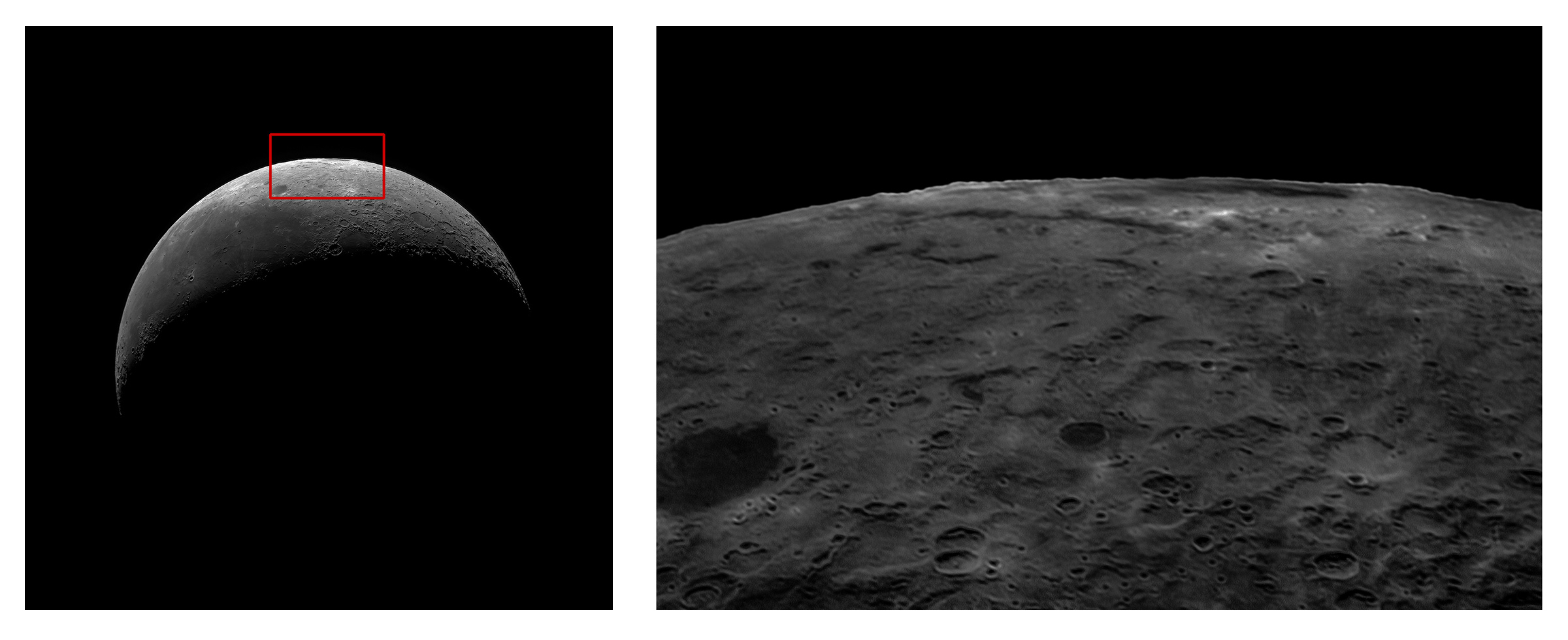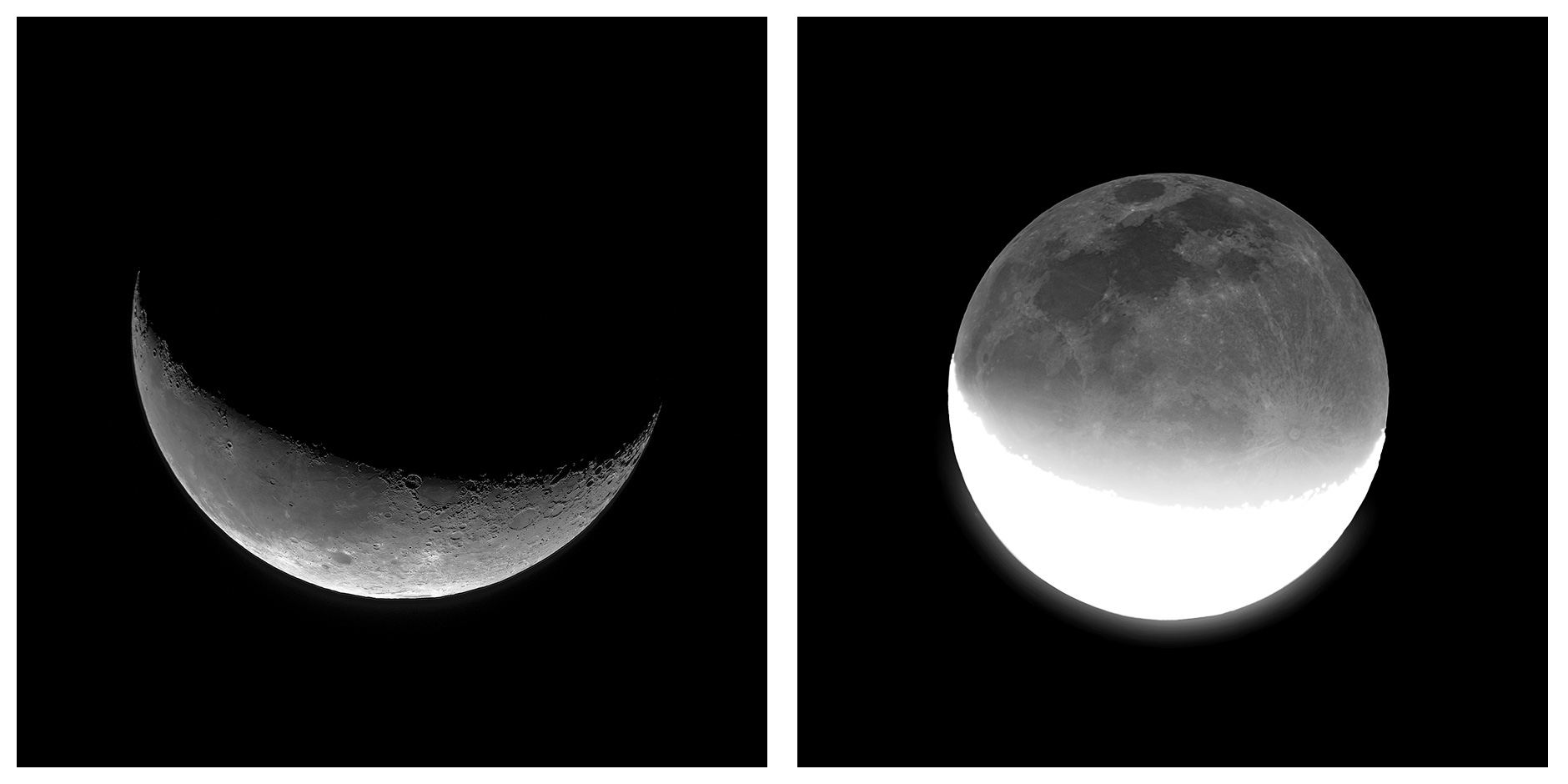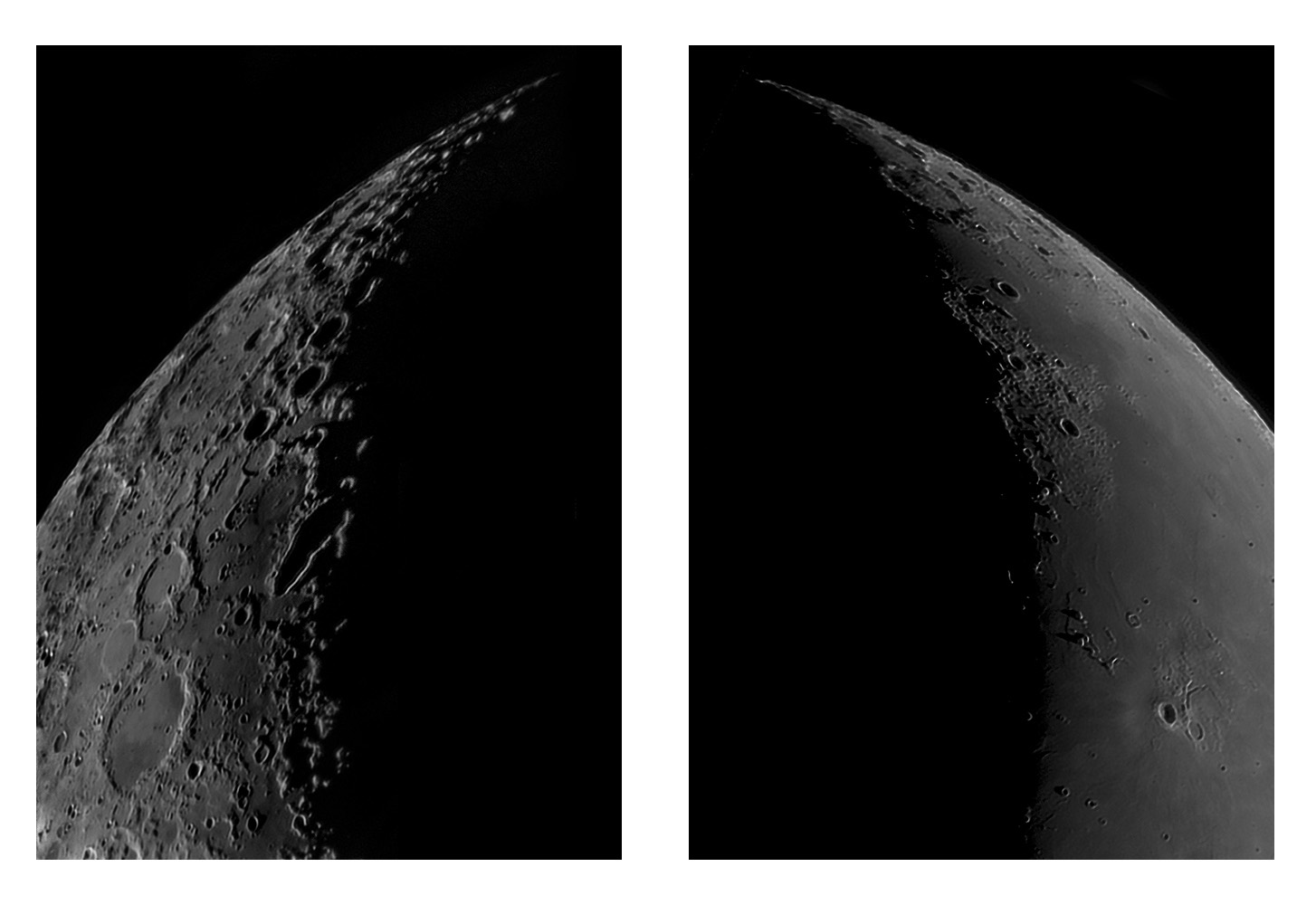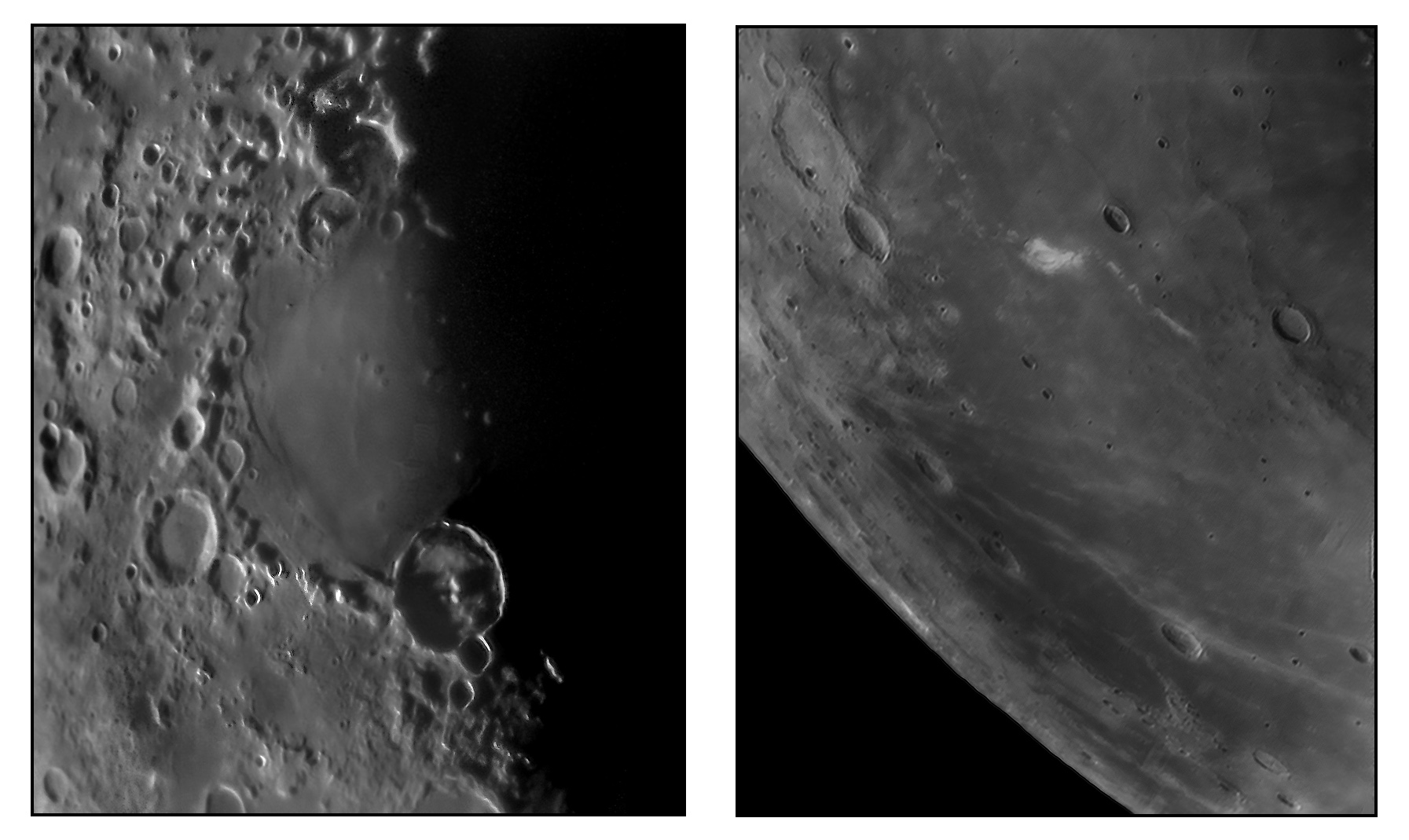Howling at the Moon, 9 :: home :: |
Mare Orientele
Click the pic for a better presentation of the photo of Mare Orientele.
10/31/2021. Not all the mysteries proposed in the previous page have been resolved. Gemma barked us awake this morning about 3:45 with a shrill explosion that left us adrenalized. About 4:30, I looked out the window and saw that the Moon was clear, and though I had wanted to shoot Mare Orientele this morning, exhaustion hd convinced me I didn't. But, well, I was awake, the night was clear, and the Moon was tilted right. Fog. Thick, low fog at the community lot said I just needed to go home and get back in bed. I could see stars overhead, but everything below about 45° was muzzy and lost. See previous rationale. I set up the kit anyway. The fog cleared away completely just after I found the Moon and focused on it leaving a virtually cloudless and steadier sky than I expected. Sometimes things work out. On the computer when I got home were 280GB of data (I'm not sure what to do with all of it, but I'm thinking), and some of it looks very good. In addition to the panorama of Mare Orientele up top, here are two diptyches. One shows the waning crescent Moon by sunlight and by Earthlight, and the other displays the very different southern and northern cusps. There are several more images to be checked out and maybe worked up. It was a busy morning.
About these diptyches. At the top of the page is the waning crescent Moon with the vicinity of Mare Orientele outlined, and a good try at imaging the Eastern Sea and its environs, including the mountains shining beyond its farther shore. Libration in lonitude was a right around -7 degrees. Next, one Moon, two exposures. The waning crescent lit by the Sun and by the waxing gibbous Earth. Then the rugged southern horn of the waning crescent contrasted wtih the Moon's smooth northern cusp. Gassendi with long evening shadows and Mare Humourum where all the shadows are due to low, cutting light from the setting Sun contrasts with Rainer Gamma, a purely albedo feature which the Virtual Moon Atlas describes as a "Formation composed with a deposit of very clear materials in form of kite. Seems to be linked with a completely gobbled ghost crater." That "gobbled ghost crater" thing makes it really apt for a Halloween morning photo. But the sharpness, the snap, the detail just aren't there in all these. First, let's try a simpler, better imaging train. The 5x Powermate will be along soon. Sooner or later, I'm gonna need a bigger 'scope. I do have one, and it's almost time to get it out again.
The 20AH lithium battery now in the Kendrick bag worked great even though I had left it plugged into the power panel for a couple of days. It showed 13.0v at the start and 12.9v at the end of the session which included a good bit of slewing hither and yon. I ordered a dedicated charger for it when I got home; even if the battery proves to be no better than the AGM battery it replaces, and it appears to be, then the back-saving aspect of the lithium-iron-phosphate cell is worthwhile. When the charger arrived, I discovered that it has lots of custom output jacks, but no way to connect it to something as simple as a small storage battery. [Alligator clips on banana plugs are on the way. Geez.... and they're here. There's some menu fumbling to get the charger to understand that it's hooked to a lithium storage battery and that the target voltage is 14.4 (not 22.2!). I set it to 2.0A and let it go. So far, so good. I think it will cut off at full charge or after six hours, whichever comes first. Watching...]
11/03/2021. Oh, hey, look what the transit finder just found:
Whattaya think? The ASI178MM behind the compressed TMB92SS taking short exposures just as fast as it can go? It's a couple of weeks out and orbits change, but keep this possibility in mind, and hope for the best. Each pixel at 402mm will be 1.23 arc seconds, and the ISS will be moving 2,274 arc seconds per second, so you'll want exposures on the order of 1/1850 second (0.54 ms, or 540 microseconds) to keep blurring under 1 pixel. That shouldn't be a problem. For perspective, the ISS will be twice the size of Aristarchus and 80% the size of Gassendi. Or would I be better off to take a little extra FL for image scale and use a smaller ROI for a higher frame rate? The ISS crossing Oceanus Procellarum would be a nice video at 100FPS or so. Or how about using the R6 behind the AT10RC at 60 FPS? If the weather's perfect, you could always try both. But check the exposure required to keep blur to one pixel in the R6/AT10 combination; it would be about 1/4000s which also seems plausible.) The path moves around a bit and finding the best observing spot takes some Google map and Streetview work. So far, the Chicken Shack on Malcolm Blvd looks really good; that's the approximate location for the plot above. Here, at the community dock, the ISS barely clips the Moon; it'll be worth traveling somewhere. [11/12/2021: but probably not as far as Old Fort which is where the path has gone as of now...]
11/3/2021. If I'm going to try any planetary imaging at all, a one-shot-color camera will be worth having. The right one could also do Moonrise duty behind the 105, 135, or 200mm lenses. The ASI462MC looks great, plus it has some nifty spectral response characteristics. In the near IR, say from 800nm to 1 micron and at least a little beyond, its sensitivity in each RGB band is phenomenal and almost equal. So apparently it should behave like a monochrome camera in that region and I might be able to ignore the Bayer matrix if used with an 850nm IR pass filter.
11/6/2021. Conversely, all that IR will flood into RGB images unless I use an IR-cut filter. I just realized that. Neither filter is expensive. The package I bought from Agena includes the 850 pass and I ordered a ZWO IR-cut as soon as I realized it would be important (my Baader IR-cut filter is the L filter in the filter-wheel, and I would prefer that it stay there). The fact that I am using an A-P/Baader MaxBright diagonal complicates considerations a little: its dielectric coatings already act like an IR-cut filter with the roll-off right around 700nm. That means that I could have dispensed with the IR-cut filter if I used the diagonal for color planetary imaging; but I don't want to have to change the imaging train that much to go from RGB to IR imaging. Hence the filter. If I always use the 462MC without the diagonal then I can choose a spectral band simply by changing filters and forego rebuilding the imaging train. I'll need to find 43mm of extension to make up for the missing diagonal's optical path-length. That shouldn't be hard. Anyway, 1.25-inch filters can be attached at the camera using an adapter I have here somewhere, or on a 1.25-inch snout, or on the 5x Powermate. 2-inch filters can go a couple of other places, too. We'll get it worked out. If not during the next clear spell, then during the one after that. I found some examples of daylight lunar images on Cloudynights. Yes! I really should be able to do decent lunar photos through that 850nm filter. What's the relative brightness of Jupiter and Amalthea in these regimes? Is the little moon easier to image in Red, 642nm, or 850nm bands?
:: top ::
|
© 2021, David Cortner




